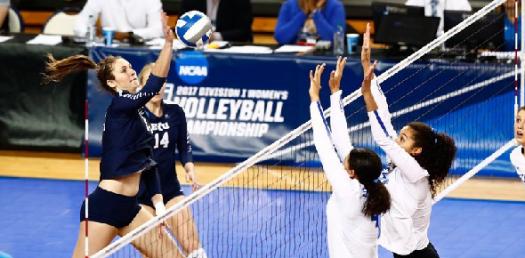In volleyball, the action can stop at any moment for a number of reasons. The cessation of play means that the ball cannot be used score a point. Anyone can touch it without consequence. If you have ever wondered “what is a dead ball in volleyball?” then read on as we give you multiple examples.
The Ball Hits the Floor or Wall
The clearest example of a dead ball is when a spiker smashes the ball on the floor of the opponent. The play is immediately halted and a point is awarded to the spiker’s team. If the ball lands on the floor outside of the lines, then the play will still be halted but the point will be awarded to the opposing team due to the error. The volleyball ball may also be considered dead if it hits other objects in and around the court including a wall, a curtain, a backboard, an advertising barrier, and the like.
The Ball Hits the Ceiling
Sometimes a spike is so powerful that defenders have a hard time controlling the ball. When they dig, the ball can go up so high that it hits the ceiling. This rarely happens but it is more likely in small venues with low ceilings. When it gets into contact with an object high above the ground, its trajectory will be affected so it is no longer considered to be playable. The game will be halted and restart according to the rules.
The Ball Touches an Antenna
The net separates the two halves of the court. The objective of the players is to take the ball above the net and make it cross to the other side. However, it must cross between the two antennas positioned at both sides. Sometimes sets are too far to the side that spikers hit the antenna when they smash the ball. This is forbidden so the referee will temporarily halt the game and award a point to the opposing team. It is also illegal to return the ball by going around the outside of or above the antenna. You really have to stay in the middle.
The Ball Fails to Cross the Net
In heated rallies, players will eventually get tired and become sloppy with their movements. Sometimes they try to return the ball to the other side but they run out of steam and the ball fails to cross the net. If they have already exhausted all three touches, then the ball is deemed dead by this point. Even if a player manages to catch the ball to prevent it from falling on the floor, it will no longer be possible to continue.
A Player Commits a Fault
Dead balls also occur if a player commits any type of fault. Perhaps a part of the body or the uniform touched the net by accident. Maybe a backline player stepped on the attach line while launching a backrow attack. Maybe the libero made an illegal move to return the ball. There could have been a service error, a double touch on a set, an overreaching call above the net, and so on.
The Referees Blows a Whistle
The first or second referee might blow the whistle for any number of reasons including an injured player, a commotion on the sidelines, foreign objects on court, a rotational error, yellow cards, and red cards. They will try to resolve the situation before allowing the game to continue.


